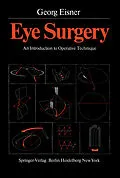The reactions to the German edition of this book have been most contradic tory. While some readers found the book absolutely unnecessary ("Surgery is learned from practice, not from theory"), others were enthusiastic (" Just the sort of book I have always needed "). In my opinion the divergent recep tion of the book is best explained by the comment of my friend, BALDER GLOOR *, who called the book a "grammar of eye surgery". Indeed there are people who can learn a language by practice alone, and there are others who do better by knowing its grammar. In learning by mere practice to be sure, proficiency will be long in coming, because it will be more difficult to recognize, and thus to correct, whatever errors are made, whereas a knowledge of grammar will reveal the basic structures and shorten the learning process. Similarly, surgery can be learned purely from practical experience. Yet the trial-and-error quest for experience is not compatible with the interests of the patient. A knowledge of "surgical grammar", on the other hand, not only shortens the time for learning but also helps us to compare different surgical techniques and to weigh thcir advantages and disadvantages. It is also helpful in developing new surgical methods, for the general rules of course, can always be applied to novel situations where experience, is lacking.
Inhalt
I Instruments and Their Use.- 1 General.- 2 The Application of Mechanical Energy.- 2.1 Instrument Handles.- 2.1.1 Manually-Operated Handles.- 2.1.2 Motorized Handles.- 2.2 The Grasping of Tissue.- 2.2.1 Non-Toothed Forceps.- 2.2.2 Toothed Forceps.- 2.2.3 Needle Holders.- 2.2.4 Tying Forceps.- 2.3 The Division of Tissues.- 2.3.1 Division Techniques.- 2.3.2 Cutting.- 2.3.3 Blades with a Point Cutting Edge.- 2.3.4 Knifes with Linear Cutting Edges.- 2.3.5 Blades with a Circular Cutting Edge (Trephines).- 2.3.6 Scissors.- 2.3.7 Needles.- 2.4 The Uniting of Tissues.- 2.4.1 Loop Sutures.- 2.4.2 Simple Running Sutures.- 2.4.3 Continuous Chain Sutures.- 2.4.4 Relationship of Suture and Suture Canal.- 2.4.5 Knots.- 3 The Application of Thermal Energy.- 3.1 The Application of Heat.- 3.1.1 Heat from an External Source.- 3.1.2 Production of Heat in the Tissue: Diathermy.- 3.1.3 Bipolar Diathermy.- 3.2 The Application of Cold.- 4 The Application of Light Energy.- 5 The Utilization of Chemical Effects (Electrolysis).- II The Significance of the Pressure Chambers of the Eye.- 1 General.- 2 The Pressure Chambers of the Eye.- 3 Effects of Pressure Changes.- 4 Deformations of the Eye and Their Effects on the Pressure Chambers.- 5 The Origin of Deformations.- 6 The Margin of Deformation.- 7 The Prevention of Deformations.- 8 Safety Strategy.- III Preparation of the Operative Field.- 1 General.- 2 Disinfection.- 3 Anesthesia.- 3.1 Instillation Anesthesia.- 3.2 Injection Anesthesia.- 3.3 Akinesia of the Orbicularis Muscle.- 3.4 Retrobulbar Anesthesia.- 3.5 Infiltration Anesthesia of the Superior Rectus Muscle.- 4 Maintaining Separation of the Lids.- 5 Fixation of the Globe.- 6 Traction Sutures for Orienting the Globe.- 7 Sutures-On Corset Rings.- 8 Placement of Transconjunctival Muscle Sutures.- IV Operations on the Conjunctiva.- 1 General.- 2 Episcleral Dissection ("Deep" Dissection).- 3 Subepithelial Dissection ("Superficial" Dissection).- 4 Suturation of the Conjunctiva.- V Operations on the Cornea and Sclera.- 1 General.- 2 Planning the Approach to the Eye Interior.- 2.1 Anatomical Factors in Opening the Globe.- 2.2 Geometric Factors in Opening the Globe.- 2.3 Comparison of Various Incision Profiles.- 3 Methods of Opening the Anterior Chamber.- 3.1 General.- 3.2 Keratome Incision.- 3.3 Cataract Knife Section.- 3.4 Cutting with Point Cutting Edges.- 3.5 Cutting with Scissors.- 3.6 Two-Plane Step Incision.- 3.7 Three-Plane Step Incision.- 3.8 Trephine Incisions.- 3.8.1 Cylindrical Trephines.- 3.8.2 Trephines with a Pointed Blade.- 3.8.3 Completion of the Trephine Incision.- 4 Suturation of the Cornea and Sclera.- VI Operations on the Iris.- 1 General.- 2 Iridectomies.- 3 Enlarging the Pupil.- 4 Repositioning of the Iris.- 5 Suturation of the Iris.- VII Operations on the Lens.- 1 General.- 2 Intracapsular Lens Delivery.- 2.1 Zonulolysis.- 2.2 Locomotion.- 2.3 Instruments for Lens Delivery.- 2.3.1 Expressors.- 2.3.2 Forceps for Grasping the Lens Capsule.- 2.3.3 Erysiphake.- 2.3.4 Cryoextractors.- 2.3.5 Criteria for the Use of Extractors.- 2.4 The Phases of a Lens Delivery.- 2.5 Methods of Lens Delivery.- 2.5.1 Expression.- 2.5.2 Combined Extraction and Expression.- 2.5.3 Extraction.- 3 Extracapsular Cataract Extraction.- 3.1 Capsulotomy.- 3.2 Locomotion in Extracapsular Extraction.- 3.3 Extraction of the Capsule.- VIII Space-Tactical Procedures.- 1 General.- 2 Fluids with Low Viscosity ("Watery Liquids").- 3 Fluids with High Viscosity ("Viscous Implants").- 4 Substances with a High Surface Tension ("Membranous Implants").- 5 Control of Space-Tactical Measures.- IX Combining Space-Tactical and Tissue-Tactical Procedures with Miniaturized Instruments.
